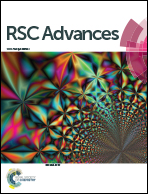Antimicrobial activities of phosphonium containing polynorbornenes†
Abstract
In this study, amphiphilic polyoxanorbornene with different alkyl and aromatic phosphonium side chains was synthesized. The biological activities of these polymers were determined by the minimal inhibitory concentration (MIC) against E. coli, S. aureus, M. tuberculosis and the yeast C. albicans, and cytotoxicity studies on red blood cells were performed. A series of polymers with different alkyl and aromatic substituents (methyl, ethyl, tripropyl, tert-butyl, phenyl, and tris 4-methoxyphenyl) and two types different molecular weight, 3000 g mol−1 and 10 000 g mol−1, were prepared. It was observed that the biological activity of the polymers with aromatic group substituents had an MIC of 16, 8, 64 and 128 μg mL−1 against E. coli, S. aureus, M. tuberculosis and C. albicans, respectively, while those with non-aromatic carbons had a higher MIC compared to those with aromatic carbons. The aromaticity of the repeat unit had impressive effects on hemolytic activities as well. Zeta potential measurements of E. coli incubated with active and inactive polymer concentration revealed a relationship between the MIC and membrane surface charge density. Polymers bearing aromatic groups killed the bacteria with widespread damage after the polymers, holding the threshold concentration, were added to the bacteria.


 Please wait while we load your content...
Please wait while we load your content...